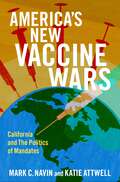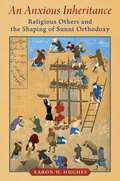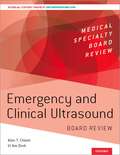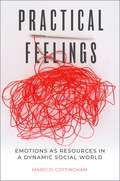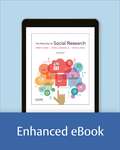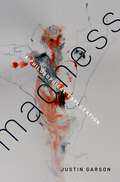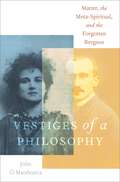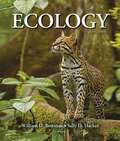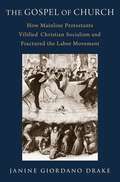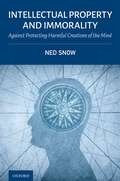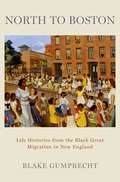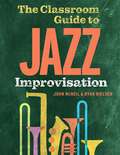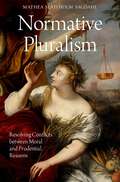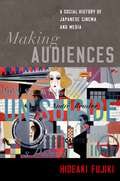- Table View
- List View
America's New Vaccine Wars: California and the Politics of Mandates
by Mark C. Navin Katie AttwellBioethicist Mark Navin and policy scholar Katie Attwell explore the evolution of American childhood vaccination policy through the prism of political history, contemporary parenthood, and diverse governance strategies. America's New Vaccine Wars focuses on the origins and the outcomes of America's recent efforts to eliminate nonmedical exemptions to school and daycare vaccine mandates. These policy developments have increased immunization rates, but they have also ignited polarizing, nationwide debates about parents' rights, democracy, and the authority of the government to use coercion to promote health. This book explores the meaning of these battles for parents, doctors, the politics of public health, and the future of bioethics. Navin and Attwell ground the book with a case study of California's efforts to exclude unvaccinated children from school and daycare following the Disneyland Measles Outbreak of 2014. The authors use original interviews with key policymakers and activists to explain the development and execution of California's new vaccination policies, and they connect California's immunization policy developments to similar efforts across America and in other countries. America's New Vaccine Wars is a story about how political and community actors fought to exclude unvaccinated children from school in the face of significant opposition and failing public health institutions. The book unpacks the meaning and impact of these efforts for broader debates about America's immunization governance, including conflicts about coercive public health measures during the COVID-19 pandemic.
An Anxious Inheritance: Religious Others and the Shaping of Sunni Orthodoxy
by Aaron W. HughesAn Anxious Inheritance reveals the tensions between the early framers of Islam and the ever-expandable category of non-Muslims. Examining the encounter with these religious others, and showing how the Qur'an functioned as both a script to understand them and a map to classify them, this study traces the key role that these religious others played in what would ultimately emerge as (Sunni) orthodoxy. This orthodoxy would appear to be the natural outgrowth of the Prophet Muhammad's preaching, but it ultimately amounted to little more than a retroactive projection of later ideas onto the earliest period. Non-Muslims (among them Christians, Jews, Zoroastrians) and the "wrong" kinds of Muslims (e.g., the Shi'a) became integral--by virtue of their perceived stubbornness, infidelity, heresy, or the like--to the understanding of what true religion was not and, just as importantly, what it should be. These non-Muslims were rarely real individuals or groups; rather, they functioned as textual foils that could be conveniently orchestrated, and ultimately controlled, to facilitate Muslim self-definition. Without such religious others proper belief could, quite literally, not be articulated. Shedding new light on the early history of Islam, while also problematizing the binary of orthodoxy/heresy in the study of religion, An Anxious Inheritance makes significant contributions to a number of diverse academic fields.
An Anxious Inheritance: Religious Others and the Shaping of Sunni Orthodoxy
by Aaron W. HughesAn Anxious Inheritance reveals the tensions between the early framers of Islam and the ever-expandable category of non-Muslims. Examining the encounter with these religious others, and showing how the Qur'an functioned as both a script to understand them and a map to classify them, this study traces the key role that these religious others played in what would ultimately emerge as (Sunni) orthodoxy. This orthodoxy would appear to be the natural outgrowth of the Prophet Muhammad's preaching, but it ultimately amounted to little more than a retroactive projection of later ideas onto the earliest period. Non-Muslims (among them Christians, Jews, Zoroastrians) and the "wrong" kinds of Muslims (e.g., the Shi'a) became integral--by virtue of their perceived stubbornness, infidelity, heresy, or the like--to the understanding of what true religion was not and, just as importantly, what it should be. These non-Muslims were rarely real individuals or groups; rather, they functioned as textual foils that could be conveniently orchestrated, and ultimately controlled, to facilitate Muslim self-definition. Without such religious others proper belief could, quite literally, not be articulated. Shedding new light on the early history of Islam, while also problematizing the binary of orthodoxy/heresy in the study of religion, An Anxious Inheritance makes significant contributions to a number of diverse academic fields.
Emergency and Clinical Ultrasound Board Review (Medical Specialty Board Review)
Emergency and Clinical Ultrasound Board Review is a comprehensive guide for preparing for the Advanced Emergency Medicine Ultrasonography or Critical Care Echocardiography board exams, and for residents preparing for in-training examinations in ultrasound. The text consists of over 500 multiple-choice questions, organized into 18 chapters covering ultrasound topics such as physics, eFAST, echocardiography, thoracic, aorta, hepatobiliary, renal, pregnancy, soft tissue, ocular, procedural, airway, ENT, DVT, testicular, abdominal, and musculoskeletal applications. This is a multi-specialty work, with contributors representing the fields of emergency medicine, internal medicine, cardiology, critical care, and radiology. Chapters include questions, answers with detailed explanations and references to primary or landmark articles to help better navigate a standardized exam. Questions are written in a case-based format that emulates the ABEM and NBE board exams, and are supplemented by over 800 figures, tables, boxes, and online videos.
Practical Feelings: Emotions as Resources in a Dynamic Social World
by Marci D. CottinghamTracing emotions across work, leisure, social media, and politics, Practical Feelings counters old myths and shows how emotions are practical resources for tackling individual and collective challenges. We do not usually think of our emotions as practical, yet they often interlace the elements of daily life. In Practical Feelings, Marci D. Cottingham develops a theory of emotion as practical resources. By integrating the sociology of emotion with practice theory, Cottingham covers diverse areas of social life to show the range of an emotion practice approach and trace how emotions are put to use in divergent domains. Spanning work, leisure, digital interactions, and the political sphere, Cottingham portrays nurses, sports fans, social media users, and political actors in more complex, holistic ways. Practical Feelings provides the conceptual tools needed to examine emotions as effort, energy, and embodied resources that calibrate us to the social world.
Practical Feelings: Emotions as Resources in a Dynamic Social World
by Marci D. CottinghamTracing emotions across work, leisure, social media, and politics, Practical Feelings counters old myths and shows how emotions are practical resources for tackling individual and collective challenges. We do not usually think of our emotions as practical, yet they often interlace the elements of daily life. In Practical Feelings, Marci D. Cottingham develops a theory of emotion as practical resources. By integrating the sociology of emotion with practice theory, Cottingham covers diverse areas of social life to show the range of an emotion practice approach and trace how emotions are put to use in divergent domains. Spanning work, leisure, digital interactions, and the political sphere, Cottingham portrays nurses, sports fans, social media users, and political actors in more complex, holistic ways. Practical Feelings provides the conceptual tools needed to examine emotions as effort, energy, and embodied resources that calibrate us to the social world.
The Process of Social Research
by Jeffrey C. Dixon Royce A. Singleton Bruce C. StraitsFeaturing a conversational, engaging, and student-friendly writing style, The Process of Social Research, Third Edition, introduces students to the fundamentals of research. It places a unique emphasis on process with flowcharts in every chapter that provide step-by-step guides for conducting social research and evaluating the research of others. The authors use relatable, everyday examples and carefully selected research examples to make the book accessible to undergraduates. Comprehensive and up-to-date without attempting to be encyclopedic in its coverage, The Process of Social Research provides a balance between qualitative and quantitative research, taking a more integrated approach to describing the relationship between theory and research.
Madness: A Philosophical Exploration
by Justin GarsonSince the time of Hippocrates, madness has typically been viewed through the lens of disease, dysfunction, and defect. Madness, like all other disease, happens when something in the mind, or in the brain, does not operate the way that it should or as nature intended. In this paradigm, the role of the healer is simply to find the dysfunction and fix it. This remains the dominant perspective in global psychiatry today. In Madness: A Philosophical Exploration, philosopher of science Justin Garson presents a radically different paradigm for conceiving of madness and the forms that it takes. In this paradigm, which he calls madness-as-strategy, madness is neither a disease nor a defect, but a designed feature, like the heart or lungs. That is to say, at least sometimes, when someone is mad, everything inside of them is working exactly as it should and as nature intended. Through rigorous engagement with texts spanning the classical era to Darwinian medicine, Garson shows that madness-as-strategy is not a new conception. Thus, more than a history of science or a conceptual genealogy, Madness is a recovery mission. In recovering madness-as-strategy, it leads us beyond today's dominant medical paradigm toward a very different form of thinking and practice. This book is essential reading for philosophers of medicine and psychiatry, particularly for those who seek to understand the nature of health, disease, and mental disorder. It will also be a valuable resource for historians and sociologists of medicine for its innovative approach to the history of madness. Most importantly, it will be useful for mental health service users, survivors, and activists, who seek an alternative and liberating vision of what it means to be mad.
Madness: A Philosophical Exploration
by Justin GarsonSince the time of Hippocrates, madness has typically been viewed through the lens of disease, dysfunction, and defect. Madness, like all other disease, happens when something in the mind, or in the brain, does not operate the way that it should or as nature intended. In this paradigm, the role of the healer is simply to find the dysfunction and fix it. This remains the dominant perspective in global psychiatry today. In Madness: A Philosophical Exploration, philosopher of science Justin Garson presents a radically different paradigm for conceiving of madness and the forms that it takes. In this paradigm, which he calls madness-as-strategy, madness is neither a disease nor a defect, but a designed feature, like the heart or lungs. That is to say, at least sometimes, when someone is mad, everything inside of them is working exactly as it should and as nature intended. Through rigorous engagement with texts spanning the classical era to Darwinian medicine, Garson shows that madness-as-strategy is not a new conception. Thus, more than a history of science or a conceptual genealogy, Madness is a recovery mission. In recovering madness-as-strategy, it leads us beyond today's dominant medical paradigm toward a very different form of thinking and practice. This book is essential reading for philosophers of medicine and psychiatry, particularly for those who seek to understand the nature of health, disease, and mental disorder. It will also be a valuable resource for historians and sociologists of medicine for its innovative approach to the history of madness. Most importantly, it will be useful for mental health service users, survivors, and activists, who seek an alternative and liberating vision of what it means to be mad.
Vestiges of a Philosophy: Matter, the Meta-Spiritual, and the Forgotten Bergson (OXFORD STU WESTERN ESOTERICISM SERIES)
by John Ó MaoilearcaVestiges of a Philosophy: Matter, the Meta-Spiritual, and the Forgotten Bergson covers a fascinating yet little known moment in history. At the turn of the twentieth century, Henri Bergson and his sister, Mina Bergson (also known as Moina Mathers), were both living in Paris and working on seemingly very different but nonetheless complementary and even correlated approaches to questions about the nature of matter, spirit, and their interaction. He was a leading professor within the French academy, soon to become the most renowned philosopher in Europe. She was his estranged sister, already celebrated in her own right as a feminist and occultist performing on theatre stages around Paris while also leading one of the most important occult societies of that era, the Hermetic Order of the Golden Dawn. One was a respectable if controversial intellectual, the other was a notorious mystic-artist who, together with her husband and fellow-occultist Samuel MacGregor Mathers, have been described as the "neo-pagan power couple" of the Belle Époque. Neither Henri nor Mina left any record of their feelings and attitudes towards the work of the other, but their views on time, mysticism, spirit, and art converge on many fronts, even as they emerged from very different forms of cultural practice. In Vestiges of a Philosophy, John Ó Maoilearca examines this convergence of ideas and uses the Bergsons' strange correlation to tackle contemporary themes in new materialist philosophy, as well as the relationship between mysticism and philosophy.
Vestiges of a Philosophy: Matter, the Meta-Spiritual, and the Forgotten Bergson (OXFORD STU WESTERN ESOTERICISM SERIES)
by John Ó MaoilearcaVestiges of a Philosophy: Matter, the Meta-Spiritual, and the Forgotten Bergson covers a fascinating yet little known moment in history. At the turn of the twentieth century, Henri Bergson and his sister, Mina Bergson (also known as Moina Mathers), were both living in Paris and working on seemingly very different but nonetheless complementary and even correlated approaches to questions about the nature of matter, spirit, and their interaction. He was a leading professor within the French academy, soon to become the most renowned philosopher in Europe. She was his estranged sister, already celebrated in her own right as a feminist and occultist performing on theatre stages around Paris while also leading one of the most important occult societies of that era, the Hermetic Order of the Golden Dawn. One was a respectable if controversial intellectual, the other was a notorious mystic-artist who, together with her husband and fellow-occultist Samuel MacGregor Mathers, have been described as the "neo-pagan power couple" of the Belle Époque. Neither Henri nor Mina left any record of their feelings and attitudes towards the work of the other, but their views on time, mysticism, spirit, and art converge on many fronts, even as they emerged from very different forms of cultural practice. In Vestiges of a Philosophy, John Ó Maoilearca examines this convergence of ideas and uses the Bergsons' strange correlation to tackle contemporary themes in new materialist philosophy, as well as the relationship between mysticism and philosophy.
Ecology: (pdf)
by William Bowman Sally HackerEcology is an easy-to-read and well-organized text for instructors and students to explore the basics and promote ecological literacy. Ecology, sixth edition, introduces readers to the beauty of nature and the importance of ecology and provides content in a way that engages students without overwhelming them in the process. The authors motivate students with an engaging case study conceptual approach that highlights relevant applications and data-driven examples.
The Gospel of Church: How Mainline Protestants Vilified Christian Socialism and Fractured the Labor Movement
by Janine Giordano DrakeIn 1908, Unitarian pastor Bertrand Thompson observed the momentous growth of the labor movement with alarm. "Socialism," he wrote, "has become a distinct substitute" for the church. He was not wrong. In the generation after the Civil War, few of the migrants who moved North and West to take jobs in factories and mines had any association with traditional Protestant denominations. In the place of church, workers built a labor movement around a shared commitment to a Christian commonwealth. They demanded an expanded local, state and federal infrastructure which supported collective bargaining for better pay, shorter work-days, and an array of municipal services. Protestant clergy worried that if the labor movement kept growing in momentum and cultural influence, socialist policies would displace the need for churches and their many ministries to the poor. Even worse, they feared that the labor movement would render the largest Protestant denominations a relic of the nineteenth century. In The Gospel of Church, Janine Giordano Drake carefully traces the relationships which Protestant ministers built with labor unions and working class communities. She finds that Protestant ministers worked hard to assert their cultural authority over Catholic, Jewish, and religiously-unaffiliated working-class communities. Moreover, they rarely supported the most important demands of labor, including freedom of speech and the right to collective bargaining. Despite their heroic narratives of Christian social reform, Protestant reformers' efforts to assert their authority over industrial affairs directly undermined workers' efforts to bring about social democracy in the United States.
The Gospel of Church: How Mainline Protestants Vilified Christian Socialism and Fractured the Labor Movement
by Janine Giordano DrakeIn 1908, Unitarian pastor Bertrand Thompson observed the momentous growth of the labor movement with alarm. "Socialism," he wrote, "has become a distinct substitute" for the church. He was not wrong. In the generation after the Civil War, few of the migrants who moved North and West to take jobs in factories and mines had any association with traditional Protestant denominations. In the place of church, workers built a labor movement around a shared commitment to a Christian commonwealth. They demanded an expanded local, state and federal infrastructure which supported collective bargaining for better pay, shorter work-days, and an array of municipal services. Protestant clergy worried that if the labor movement kept growing in momentum and cultural influence, socialist policies would displace the need for churches and their many ministries to the poor. Even worse, they feared that the labor movement would render the largest Protestant denominations a relic of the nineteenth century. In The Gospel of Church, Janine Giordano Drake carefully traces the relationships which Protestant ministers built with labor unions and working class communities. She finds that Protestant ministers worked hard to assert their cultural authority over Catholic, Jewish, and religiously-unaffiliated working-class communities. Moreover, they rarely supported the most important demands of labor, including freedom of speech and the right to collective bargaining. Despite their heroic narratives of Christian social reform, Protestant reformers' efforts to assert their authority over industrial affairs directly undermined workers' efforts to bring about social democracy in the United States.
Intellectual Property and Immorality: Against Protecting Harmful Creations of the Mind
by Ned SnowShould a machine that emits harmful levels of pollution receive patent protection? Should pornography receive copyright protection? This book argues that certain intellectual creations should not receive patent or copyright protection on the grounds that those works are harmful to society. The book posits that the theories of intellectual property and the Intellectual Property Clause of the U.S. Constitution suggest this conclusion. It also considers several counterarguments: in particular, that denying protection might increase the output of objectionable works, that other laws should address moral problems, and that intellectual property functions better under a laissez-faire approach. Despite these counterarguments, the book contends that law should never encourage or reward harmful behavior. This simple principle implies that courts should exercise their equitable powers to deny enforcement of intellectual property for works involving unlawful conduct. It implies that courts should deny protection for works that clearly fall outside the Intellectual Property Clause's scope of protectable works. And it implies that Congress should consider denying protection for works that pose clear harms to society. The book also addresses the intersection between denying intellectual property protection and maintaining free speech protection. In that regard, the book recognizes that the Free Speech Clause severely limits Congress's discretionary authority to deny copyright protection for expression that it deems immoral. The book concludes that courts, Congress, and government agencies should exercise limited discretion in deciding whether certain intellectual works are morally eligible for intellectual property protection.
Intellectual Property and Immorality: Against Protecting Harmful Creations of the Mind
by Ned SnowShould a machine that emits harmful levels of pollution receive patent protection? Should pornography receive copyright protection? This book argues that certain intellectual creations should not receive patent or copyright protection on the grounds that those works are harmful to society. The book posits that the theories of intellectual property and the Intellectual Property Clause of the U.S. Constitution suggest this conclusion. It also considers several counterarguments: in particular, that denying protection might increase the output of objectionable works, that other laws should address moral problems, and that intellectual property functions better under a laissez-faire approach. Despite these counterarguments, the book contends that law should never encourage or reward harmful behavior. This simple principle implies that courts should exercise their equitable powers to deny enforcement of intellectual property for works involving unlawful conduct. It implies that courts should deny protection for works that clearly fall outside the Intellectual Property Clause's scope of protectable works. And it implies that Congress should consider denying protection for works that pose clear harms to society. The book also addresses the intersection between denying intellectual property protection and maintaining free speech protection. In that regard, the book recognizes that the Free Speech Clause severely limits Congress's discretionary authority to deny copyright protection for expression that it deems immoral. The book concludes that courts, Congress, and government agencies should exercise limited discretion in deciding whether certain intellectual works are morally eligible for intellectual property protection.
North to Boston: Life Histories from the Black Great Migration in New England
by Blake GumprechtBetween World War II and 1980, tens of thousands of Black people moved to Boston from the South as part of the Great Migration, one of the most consequential mass movements of people in American history. Black migration from the South transformed the city, as it did urban areas across the country. North to Boston is the first book to examine that important subject. Blake Gumprecht traces the history of this migration and explores its impacts in greater depth through the lives of ten individuals, each the subject of one chapter. Those chapters are short biographies based on extensive interviews by the author and are told in an engaging style that reflects the author's background as a journalist. The ten people featured came from six southern states. They fled racism, limited opportunity, and hopelessness, and moved north in pursuit of better jobs, equal treatment, and greater freedom. They settled in neighborhoods such as Roxbury, Dorchester, and Mattapan. They worked as teachers, factory workers, welders, and security guards. Their stories are emblematic of the experiences of Black people everywhere who left the South, and provide a rare glimpse into the lives of ordinary people living in one city's Black community. North to Boston brings to life the history of the Great Migration, revealing a hidden aspect of New England's history and shining a spotlight on a singularly important event in the making of Black Boston.
North to Boston: Life Histories from the Black Great Migration in New England
by Blake GumprechtBetween World War II and 1980, tens of thousands of Black people moved to Boston from the South as part of the Great Migration, one of the most consequential mass movements of people in American history. Black migration from the South transformed the city, as it did urban areas across the country. North to Boston is the first book to examine that important subject. Blake Gumprecht traces the history of this migration and explores its impacts in greater depth through the lives of ten individuals, each the subject of one chapter. Those chapters are short biographies based on extensive interviews by the author and are told in an engaging style that reflects the author's background as a journalist. The ten people featured came from six southern states. They fled racism, limited opportunity, and hopelessness, and moved north in pursuit of better jobs, equal treatment, and greater freedom. They settled in neighborhoods such as Roxbury, Dorchester, and Mattapan. They worked as teachers, factory workers, welders, and security guards. Their stories are emblematic of the experiences of Black people everywhere who left the South, and provide a rare glimpse into the lives of ordinary people living in one city's Black community. North to Boston brings to life the history of the Great Migration, revealing a hidden aspect of New England's history and shining a spotlight on a singularly important event in the making of Black Boston.
The Classroom Guide to Jazz Improvisation
by John McNeil Ryan NielsenYou don't have to be a jazz expert to give your students a great introduction to improvisation. The Classroom Guide to Jazz Improvisation provides what music educators have sought for decades: an easy, step-by-step guide to teaching jazz improvisation in the music classroom. Offering classroom-tested lesson plans, authors John McNeil and Ryan Nielsen draw on their combined 54 years of teaching experience and extensive work as professional jazz musicians to remove the guesswork and mystique from the teaching process. Each lesson is founded in the authors' realization that the brain responds differently to improvisation than it does rote memory. The resulting lesson plans are flexible, easy to use, and equip students with a quick understanding of the simple choices they can make to create effective jazz lines. Lessons are designed for a range of settings, from ensemble rehearsal to private instruction. Music educators may find relief in the concrete, straightforward materials on rhythm section instruments like bass, drums, piano, and guitar. Beyond the nuts and bolts of improvisation, this book contains carefully curated listening lists, honest discussions about the meaning of the music, and talking points to advocate for jazz programs to administrators and parents. With an inviting and conversational approach, The Classroom Guide to Jazz Improvisation is an essential resource for all music educators, from early career teachers to seasoned instructors.
The Classroom Guide to Jazz Improvisation
by John McNeil Ryan NielsenYou don't have to be a jazz expert to give your students a great introduction to improvisation. The Classroom Guide to Jazz Improvisation provides what music educators have sought for decades: an easy, step-by-step guide to teaching jazz improvisation in the music classroom. Offering classroom-tested lesson plans, authors John McNeil and Ryan Nielsen draw on their combined 54 years of teaching experience and extensive work as professional jazz musicians to remove the guesswork and mystique from the teaching process. Each lesson is founded in the authors' realization that the brain responds differently to improvisation than it does rote memory. The resulting lesson plans are flexible, easy to use, and equip students with a quick understanding of the simple choices they can make to create effective jazz lines. Lessons are designed for a range of settings, from ensemble rehearsal to private instruction. Music educators may find relief in the concrete, straightforward materials on rhythm section instruments like bass, drums, piano, and guitar. Beyond the nuts and bolts of improvisation, this book contains carefully curated listening lists, honest discussions about the meaning of the music, and talking points to advocate for jazz programs to administrators and parents. With an inviting and conversational approach, The Classroom Guide to Jazz Improvisation is an essential resource for all music educators, from early career teachers to seasoned instructors.
Normative Pluralism: Resolving Conflicts between Moral and Prudential Reasons (Oxford Moral Theory)
by Mathea Slåttholm SagdahlThe potential conflicts between morality and self-interest lie at the heart of ethics. These conflicts arise because both moral and prudential considerations apply to our choices. A widespread assumption in philosophical ethics is that by weighing moral and prudential reasons against each other, we can compare their relative weights and determine what we ought to do in the face of such conflicts. While this assumption might seem innocuous and fruitful, a closer examination suggests that it lacks both justification and the necessary content that would allow it to do the normative work it promises. In this book, Mathea Slåttholm Sagdahl grapples with these cases of conflict, but argues that there may be no simple answer to the question of what we ought to do all things considered. Sagdahl argues against the assumption of comparability and defends an alternative pluralist theory of normativity where morality and prudence form two separate and incommensurable normative standpoints, much like in Henry Sidgwick's "Dualism of Practical Reason." This type of view has tended to be quickly dismissed by its opponents, but Sagdahl argues that the theory is in fact a well-motivated theory of normativity and that the typical objections that tend to target it are much weaker than they are usually thought to be.
Normative Pluralism: Resolving Conflicts between Moral and Prudential Reasons (Oxford Moral Theory)
by Mathea Slåttholm SagdahlThe potential conflicts between morality and self-interest lie at the heart of ethics. These conflicts arise because both moral and prudential considerations apply to our choices. A widespread assumption in philosophical ethics is that by weighing moral and prudential reasons against each other, we can compare their relative weights and determine what we ought to do in the face of such conflicts. While this assumption might seem innocuous and fruitful, a closer examination suggests that it lacks both justification and the necessary content that would allow it to do the normative work it promises. In this book, Mathea Slåttholm Sagdahl grapples with these cases of conflict, but argues that there may be no simple answer to the question of what we ought to do all things considered. Sagdahl argues against the assumption of comparability and defends an alternative pluralist theory of normativity where morality and prudence form two separate and incommensurable normative standpoints, much like in Henry Sidgwick's "Dualism of Practical Reason." This type of view has tended to be quickly dismissed by its opponents, but Sagdahl argues that the theory is in fact a well-motivated theory of normativity and that the typical objections that tend to target it are much weaker than they are usually thought to be.
Making Audiences: A Social History of Japanese Cinema and Media
by Hideaki FujikiFilm has always been a key technology for producing and disseminating attachments to 'the social.' Making Audiences explores the century-old relationships between Japanese media and social subjects, analyzing the connections between cinema audiences and five significant discursive terms: minshu (the people), kokumin (the national populace), toa minzoku (the East Asian race), taishu (the masses), and shimin (citizens). Fujiki narrates the history of Japan's transmedia ecology, illuminating cinema's enmeshment with other forms of media, from vaudeville to the internet, so that cinema audiences emerge as simultaneously shaped by and shaping social history. His extensive empirical research and commitment to interdisciplinarity bring new perspective to the history of Japanese society and culture in its global context from the early twentieth century up to the beginning of the twenty-first century, setting his insights within the context of total wars, imperialism, gender, ethnicity, mass society and communication, the ethics of care, citizenship, globalization, neoliberalism, social movements, digital media, and public and intimate spheres. By reorganizing the study of film and its audiences as central players of the history and politics of the 20th century, Fujiki writes the history of Japan and East Asia anew.
Making Audiences: A Social History of Japanese Cinema and Media
by Hideaki FujikiFilm has always been a key technology for producing and disseminating attachments to 'the social.' Making Audiences explores the century-old relationships between Japanese media and social subjects, analyzing the connections between cinema audiences and five significant discursive terms: minshu (the people), kokumin (the national populace), toa minzoku (the East Asian race), taishu (the masses), and shimin (citizens). Fujiki narrates the history of Japan's transmedia ecology, illuminating cinema's enmeshment with other forms of media, from vaudeville to the internet, so that cinema audiences emerge as simultaneously shaped by and shaping social history. His extensive empirical research and commitment to interdisciplinarity bring new perspective to the history of Japanese society and culture in its global context from the early twentieth century up to the beginning of the twenty-first century, setting his insights within the context of total wars, imperialism, gender, ethnicity, mass society and communication, the ethics of care, citizenship, globalization, neoliberalism, social movements, digital media, and public and intimate spheres. By reorganizing the study of film and its audiences as central players of the history and politics of the 20th century, Fujiki writes the history of Japan and East Asia anew.
